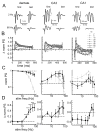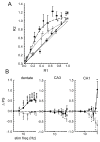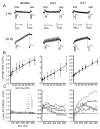Modulation by pregnenolone sulfate of filtering properties in the hippocampal trisynaptic circuit
- PMID: 22648992
- PMCID: PMC3434266
- DOI: 10.1002/hipo.22038
Modulation by pregnenolone sulfate of filtering properties in the hippocampal trisynaptic circuit
Abstract
Short-term synaptic plasticity alters synaptic efficacy on a timescale that is relevant to encoding information in spike trains. The dynamics of this plasticity, combined with that of the feedback and feedforward contributions of local interneurons, impose frequency-dependent properties on neuronal networks with implications for nervous system function. The trisynaptic network of the hippocampus is especially well suited to selectively filter components of frequency-dependent signals that are transmitted from the entorhinal cortex. We measured presynaptic [Ca(2+)](i) in perforant path, mossy fiber, or Schaffer collateral terminals while simultaneously measuring field potentials of principal cells of the dentate, CA3, or CA1 synaptic fields over a range of stimulus frequencies of 2 to 77 Hz. In all three synaptic fields, the average [Ca(2+)](i) during a 500 ms stimulus train rose monotonically with stimulus frequency. The average population spike amplitude during this stimulus train, however, exhibited a non-linear relationship to frequency that was distinct for each of the three synaptic fields. The dentate synaptic field exhibited the characteristics of a low pass filter, while both CA synaptic fields had bandpass filter characteristics with a gain that was greater than 1 in the passband frequencies. Importantly, alteration of the dynamic properties of this network could significantly impact information processing performed by the hippocampus. Pregnenolone sulfate (PregS), has frequency-dependent effects on paired- and multipulse plasticity in the dentate and CA1 synaptic fields of the hippocampal formation. We investigated the PregS-dependent modulation of the dynamic properties of transmission by the principal cells of the three hippocampal synaptic fields. Importantly, PregS is capable of altering the pattern separation capabilities that may underlie hippocampal information processing.
Copyright © 2012 Wiley Periodicals, Inc.
Figures







Similar articles
-
Regional differences in GABAergic modulation for TEA-induced synaptic plasticity in rat hippocampal CA1, CA3 and dentate gyrus.Neurosci Res. 2007 Oct;59(2):183-90. doi: 10.1016/j.neures.2007.06.1472. Epub 2007 Jun 28. Neurosci Res. 2007. PMID: 17669533
-
A computational study on plasticity during theta cycles at Schaffer collateral synapses on CA1 pyramidal cells in the hippocampus.Hippocampus. 2015 Feb;25(2):208-18. doi: 10.1002/hipo.22365. Epub 2014 Sep 25. Hippocampus. 2015. PMID: 25220633
-
Clinically relevant concentrations of ketamine mainly affect long-term potentiation rather than basal excitatory synaptic transmission and do not change paired-pulse facilitation in mouse hippocampal slices.Brain Res. 2014 Apr 29;1560:10-7. doi: 10.1016/j.brainres.2014.03.004. Epub 2014 Mar 15. Brain Res. 2014. PMID: 24637258
-
The CA3 "backprojection" to the dentate gyrus.Prog Brain Res. 2007;163:627-37. doi: 10.1016/S0079-6123(07)63034-9. Prog Brain Res. 2007. PMID: 17765742 Free PMC article. Review.
-
Interneuron diversity series: containing the detonation--feedforward inhibition in the CA3 hippocampus.Trends Neurosci. 2003 Nov;26(11):631-40. doi: 10.1016/j.tins.2003.09.007. Trends Neurosci. 2003. PMID: 14585604 Review.
Cited by
-
Pregnenolone sulfate as a modulator of synaptic plasticity.Psychopharmacology (Berl). 2014 Sep;231(17):3537-56. doi: 10.1007/s00213-014-3643-x. Epub 2014 Jul 6. Psychopharmacology (Berl). 2014. PMID: 24997854 Free PMC article. Review.
-
Current View on PPAR-α and Its Relation to Neurosteroids in Alzheimer's Disease and Other Neuropsychiatric Disorders: Promising Targets in a Therapeutic Strategy.Int J Mol Sci. 2024 Jun 28;25(13):7106. doi: 10.3390/ijms25137106. Int J Mol Sci. 2024. PMID: 39000217 Free PMC article. Review.
-
Neurosteroid Actions in Memory and Neurologic/Neuropsychiatric Disorders.Front Endocrinol (Lausanne). 2019 Apr 9;10:169. doi: 10.3389/fendo.2019.00169. eCollection 2019. Front Endocrinol (Lausanne). 2019. PMID: 31024441 Free PMC article. Review.
-
Novel functions of GABA signaling in adult neurogenesis.Front Biol (Beijing). 2013 Oct 1;8(5):10.1007/s11515-013-1270-2. doi: 10.1007/s11515-013-1270-2. Front Biol (Beijing). 2013. PMID: 24285940 Free PMC article.
-
Low-Frequency Pulsed Magnetic Field Improves Depression-Like Behaviors and Cognitive Impairments in Depressive Rats Mainly via Modulating Synaptic Function.Front Neurosci. 2019 Aug 20;13:820. doi: 10.3389/fnins.2019.00820. eCollection 2019. Front Neurosci. 2019. PMID: 31481866 Free PMC article.
References
-
- Andersen P. Organization of hippocampal neurons and their interconnections. In: Pribram RIK, editor. The Hippocampus Volume I: Structure and Development. New York: Plenum; 1975. pp. 155–175.
Publication types
MeSH terms
Substances
Grants and funding
LinkOut - more resources
Full Text Sources
Miscellaneous

